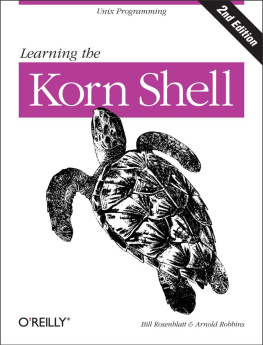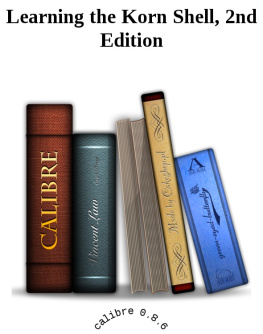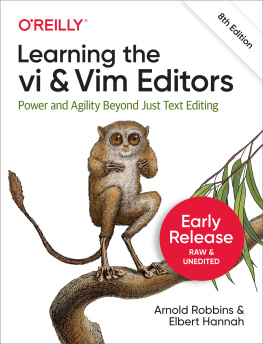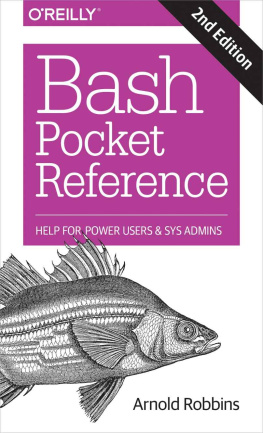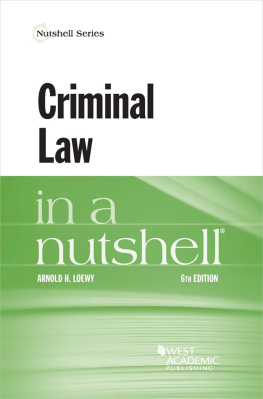Arnold Robbins - Unix in a Nutshell
Here you can read online Arnold Robbins - Unix in a Nutshell full text of the book (entire story) in english for free. Download pdf and epub, get meaning, cover and reviews about this ebook. year: 2009, publisher: O’Reilly Media, genre: Computer. Description of the work, (preface) as well as reviews are available. Best literature library LitArk.com created for fans of good reading and offers a wide selection of genres:
Romance novel
Science fiction
Adventure
Detective
Science
History
Home and family
Prose
Art
Politics
Computer
Non-fiction
Religion
Business
Children
Humor
Choose a favorite category and find really read worthwhile books. Enjoy immersion in the world of imagination, feel the emotions of the characters or learn something new for yourself, make an fascinating discovery.
- Book:Unix in a Nutshell
- Author:
- Publisher:O’Reilly Media
- Genre:
- Year:2009
- Rating:3 / 5
- Favourites:Add to favourites
- Your mark:
- 60
- 1
- 2
- 3
- 4
- 5
Unix in a Nutshell: summary, description and annotation
We offer to read an annotation, description, summary or preface (depends on what the author of the book "Unix in a Nutshell" wrote himself). If you haven't found the necessary information about the book — write in the comments, we will try to find it.
Unix in a Nutshell — read online for free the complete book (whole text) full work
Below is the text of the book, divided by pages. System saving the place of the last page read, allows you to conveniently read the book "Unix in a Nutshell" online for free, without having to search again every time where you left off. Put a bookmark, and you can go to the page where you finished reading at any time.
Font size:
Interval:
Bookmark:

Beijing Cambridge Farnham Kln Sebastopol Tokyo
To my wife, Miriam. May our dreams continue to come true .
To my children, Chana, Rivka, Nachum, and Malka .
To the memory of Frank Willison .
The fourth edition of Unix in a Nutshell brings the book into the 21st century. The term UNIX is a registered trademark of The Open Group. It is used for branding systems as compliant with the various standards that collectively define the behavior of a modern Unix system. More informally though, many systems in use today are Unix work-alikes, even though their source code base was developed independently from the original Unix systems.
Thus, the goal of this edition to present the broader state of Unix in todays world. In particular, its important to cover both the commercial variants, and those where source code for the system and the utilities are freely available. To this end, we have chosen to cover these systems, which are representative of Unix today:
Solaris is the most popular commercial system based on the original Unix System V code base.
GNU/LinuxGNU/Linux systems have gained a huge foothold in the commercial marketplace. While currently used most heavily for back-end servers, GNU/Linux is also starting to gain ground in the desktop market.
Mac OS XApples rewrite of their operating system has a core based on Mach and various BSD technologies. The command set is derived from FreeBSD. Thus, besides having an exciting user interface, Mac OS X is representative of the BSD strain of free Unix-like systems.
The commands covered by the current POSIX standard form the core of our presentation. Each specific system has commands that are unique to it; these are covered too. Finally, many important and useful utilities are distributed as Free or Open Source software on the Internet. We have done our best to cover those as well, including presenting the Internet URL from which you can download the source code, in case your particular system doesnt include that utility in its distribution.
This edition has the following new features:
Covers Solaris 10, the latest version of the SVR4-based operating system from Sun Microsystems,[] GNU/Linux, and Mac OS X.
, Unix Commands, has been heavily reorganized and revised, in order to cover the three systems.
]ksh93, and tcsh.
, The Bash and Korn Shells, now covers the popular Bash shell, along with the 1988 and 1993 versions of ksh. Coverage of the vanilla Bourne shell has been dropped.
, tcsh: An Extended C Shell, now covers the widely-used tcsh shell instead of the original Berkeley csh.
, Package Management, is new. It covers package management programs, which are used for program installation on popular GNU/Linux systems. It also describes similar facilities for Solaris and Mac OS X.
, The Emacs Editor, now covers GNU Emacs Version 21.
, The vi, ex, and vim Editors, now contains merged coverage of the vi and ex text editors. Important commands and features from the popular vim editor are also included.
, The sed Editor, now includes coverage of GNU sed.
The coverage of awk in , The awk Programming Language, has been updated as well, dropping separate coverage of the original, old awk.
, Source Code Management: An Overview, which provides an introduction to source code management systems, has been added.
, The Concurrent Versions System, on CVS, has been added.
, The Subversion Version Control System, on the Subversion version control system, is brand new.
, The GNU make Utility, has been revised to focus on GNU Make.
, The GDB Debugger, on the GDB debugger, is brand new.
As time marches on, once-popular or necessary commands fall into disuse. Thus, with the exception of , which describes how to write a manual page, all the material on the venerable troff text formatting suite has been removed from the book. We have also removed the previous editions material on SCCS and on obsolete commands.
[] The version used for this book was for Intel x86-based systems.
[] Because the Free Software Foundation treats Bash and Emacs as proper nouns, we do too, here and throughout the book.
This book should be of interest to Unix users and Unix programmers, as well as to anyone (such as a system administrator) who might offer direct support to users and programmers. The presentation is geared mainly toward people who are already familiar with the Unix system; that is, you know what you want to do, and you even have some idea how to do it. You just need a reminder about the details. For example, if you want to remove the third field from a database, you might think, " I know I can use thecutcommand, but what are the options? " In many cases, specific examples are provided to show how a command is used.
We have purposely chosen to omit system administration commands. System administration is a complicated topic in its own right, and the Bibliography lists several good books on this important subject.
This reference might also help people who are familiar with some aspects of Unix but not with others. Many chapters include an overview of the particular topic. While this isnt meant to be comprehensive, its usually sufficient to get you started in unfamiliar territory.
Finally, if youre new to the Unix operating system, and youre feeling bold, you might appreciate this book as a quick tour of what Unix has to offer. The Beginners Guide section in can point you to the most useful commands, and youll find brief examples of how to use them, but take note: this book should not be used in place of a good beginners tutorial on Unix. (You might try Learning the Unix Operating System for that.) This reference should be a supplement , not a substitute. (There are references throughout the text to other relevant OReilly books that will help you learn the subject matter under discussion; you may be better off detouring to those books first. Also, see the Bibliography.)
Unix in a Nutshell , Fourth Edition, is divided into four parts:
also covers package management.
begins with a review of pattern matching, including examples geared toward specific editors.
) summarizes the Unix utilities for software developmentRCS, CVS, Subversion, make and GDB. It also covers, in brief, what you need to know to write a manual page for your programs.
contains a table of ISO Latin-1 characters and equivalent values ( ISO 8859-1 (Latin-1) Character Set ) and a Bibliography of Unix books.
This book follows certain typographic conventions, outlined below:
Constant widthis used for directory names, filenames, commands, program names, functions, and options. All terms shown in constant width are typed literally. It is also used to show the contents of files or the output from commands.
Font size:
Interval:
Bookmark:
Similar books «Unix in a Nutshell»
Look at similar books to Unix in a Nutshell. We have selected literature similar in name and meaning in the hope of providing readers with more options to find new, interesting, not yet read works.
Discussion, reviews of the book Unix in a Nutshell and just readers' own opinions. Leave your comments, write what you think about the work, its meaning or the main characters. Specify what exactly you liked and what you didn't like, and why you think so.


